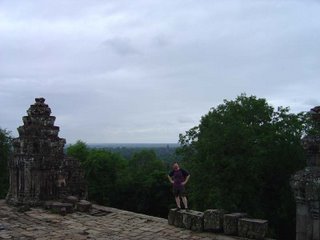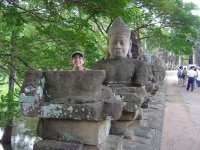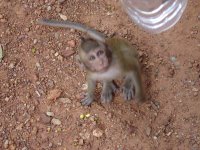Angkor, Part 1: Angkor Wat
Angkor Wat: a reason to travel to the other side of the world.

The only photos that capture this size of this thing are those taken from helicopters, and then you can't get a sense of scale. This image looks east from the western Gateway. The structure on the near left is the North Library.
The Khmer empire used its massive wealth during the Angkor period to build a series of great temples and other public works at their capital north of the Tonle Sap lake. Many of these structures still stand a thousand years later, the largest and most famous of
 which is Angkor Wat ("Great Temple"), the world's largest religious structure. It's glorious. The Angkor archeological park consists of many different structures, from the walled city of Angkor Thom to the vast resoviors, the east and west Barays, that once watered the agricultural engine of the mighty empire. All of these were left to ruin at one time or another... except Angkor Wat, which has remained a functioning temple throughout its history, even during the disturbing civil war period and the reign of Pol Pot, when hundreds of wats were destroyed and thousands of monks put to the sword.
which is Angkor Wat ("Great Temple"), the world's largest religious structure. It's glorious. The Angkor archeological park consists of many different structures, from the walled city of Angkor Thom to the vast resoviors, the east and west Barays, that once watered the agricultural engine of the mighty empire. All of these were left to ruin at one time or another... except Angkor Wat, which has remained a functioning temple throughout its history, even during the disturbing civil war period and the reign of Pol Pot, when hundreds of wats were destroyed and thousands of monks put to the sword. Here I am atop another temple, Phnom Bakheng, about a kilometer away from Angkor Wat. You can see its spires in the distance just above my head. Click on any image to see it bigger.
Here I am atop another temple, Phnom Bakheng, about a kilometer away from Angkor Wat. You can see its spires in the distance just above my head. Click on any image to see it bigger.I'll try and leave most of the factual information to the Wikipedia link at the top of this post and focus on impressions, although it's very difficult to put into words.
Amy and I arrived in Siem Reap on the night of the 11th and settled into a hotel. By chance, we ran into our friend Verena, whom we had met on the boat ride up the Mekong, and ate dinner with her. For the first of our three days exploring the temples, we chose to rent bicycles and ride to the park, about five kilometers (3 miles) away. A bit of bad navigation sent us far off course and turned the thirty minute ride into about an hour and a half... in midday sun. Doh! The land is quite flat, though, and the roads were excellent. When we realized our mistake we finally approached Angkor Wat from the east. We first saw what appeared to be a broad river with a tree lined shore opposite. We turned left and followed this south for half a mile until the "river" made an abrupt right angle turn to the west, making me realize that this was the moat that surrounds the temple.


Taken from the southwest corner of the moat, looking north. In the distance you can just make out the causeway.
This navigation error meant that we approached the temple from the rear, and rode around the moat clockwise until we reached the main entrance at the west. Wow is it big.

What this map calls "the city" would have been where the palaces, administrative offices and such of the kingdom were found. According to Khmer custom, though, people lived and worked in structures of wood, while only the gods deserved structures of stone. Thus, the temple is all that remains.
 After water and gatorade cured us of our long hot ride, we walked along the causeway and entered the inner courtyard. Many small shrines exist along the
After water and gatorade cured us of our long hot ride, we walked along the causeway and entered the inner courtyard. Many small shrines exist along the way, often to images of the Buddha that have been partially destroyed (some of the best preserved images have been moved to the national museum in Phnom Penh.) Once inside the inner courtyard, I climbed this staircase to reach the highest publicly accessible part of the temple. These monks were hardcore in that they walked down this stair with only the occasional hand to steady them. When I got to the top I learned that a
way, often to images of the Buddha that have been partially destroyed (some of the best preserved images have been moved to the national museum in Phnom Penh.) Once inside the inner courtyard, I climbed this staircase to reach the highest publicly accessible part of the temple. These monks were hardcore in that they walked down this stair with only the occasional hand to steady them. When I got to the top I learned that a similar staircase on the south side had been equipped with a handrail- that's the one I used to get down. Here's what it looked like from the top: steep, broken up and super smooth. You'd think people had been climbing up and down the thing for a millennium or something.
similar staircase on the south side had been equipped with a handrail- that's the one I used to get down. Here's what it looked like from the top: steep, broken up and super smooth. You'd think people had been climbing up and down the thing for a millennium or something.Angkor Wat is very difficult to describe adequately- just thinking about it is frustrating. It's big, graceful, serene, serious, and yet also relaxed and unintimidating (except for the climbing!). If you can, see it before you die. Amy and I returned to Angkor Wat each day for a little bit, in an effort to make it stick in our brains a little better, or to appreciate it on some level beyond that first moment of dumbstruck awe. I don't know if I succeeded. I get the impression you could live next to it and still have that same feeling each time you set foot in the place.
For lunch we had the fish of the Tonle Sap lake cooked in a small hill of lemongrass. Incredible.
Next up, we walked north into the park to the next large monument, the walled city of Angkor Thom ("Great City"). There's a moat of sorts surrounding the wall, and lining the causeway over the moat we met these fellas. These statues are ten feet tall,
 and there are at least fifty of them lining each side of the causeway. Although many of them were defaced or beheaded by subsequent conquerors, you can still see that they're carrying something thick and cylindrical, like in a tug of war. This represents an very cool story from a Hindu creation myth.* The gods and the demons make a deal: they'll team up to perform an impossible task. At the center of the Sea of Milk lies a great mountain, and wrapped around it is a giant snake. They capture the snake, and with the center of it still encircling the mountain, the gods
and there are at least fifty of them lining each side of the causeway. Although many of them were defaced or beheaded by subsequent conquerors, you can still see that they're carrying something thick and cylindrical, like in a tug of war. This represents an very cool story from a Hindu creation myth.* The gods and the demons make a deal: they'll team up to perform an impossible task. At the center of the Sea of Milk lies a great mountain, and wrapped around it is a giant snake. They capture the snake, and with the center of it still encircling the mountain, the gods  line up on one side and the demons on the other, and they pull alternately on the snake for a thousand years, thus twisting the mountain and churning the Sea of Milk to produce the Elixir of Immortality that both sides want. As the elixir begins to appear, the gods go back on the deal and try to steal it all for themselves, thus planting the seed of the war between good and evil. I guess Amy wanted her turn at churning the milk, despite her dislike of snakes.
line up on one side and the demons on the other, and they pull alternately on the snake for a thousand years, thus twisting the mountain and churning the Sea of Milk to produce the Elixir of Immortality that both sides want. As the elixir begins to appear, the gods go back on the deal and try to steal it all for themselves, thus planting the seed of the war between good and evil. I guess Amy wanted her turn at churning the milk, despite her dislike of snakes.Once through the gates of the city, we proceeded north up the long road towards the Bayon, the temple at its center. In
 its day, the city would have been full of wooden structures, but now it's given over to trees, grass, and most endearingly, monkeys. These guys were awesome. I have since learned that it probably
its day, the city would have been full of wooden structures, but now it's given over to trees, grass, and most endearingly, monkeys. These guys were awesome. I have since learned that it probably  wasn't a smooth idea to get so close to these varmits, as they can carry rabies, but look at them- they're like little fuzzy people! This infant in particular took a shine to me, so much so that I
wasn't a smooth idea to get so close to these varmits, as they can carry rabies, but look at them- they're like little fuzzy people! This infant in particular took a shine to me, so much so that I was worried that Mom would get upset, but she watched me interact with him the whole time and was pretty nonplussed. They must see hundreds of tourists a day.
was worried that Mom would get upset, but she watched me interact with him the whole time and was pretty nonplussed. They must see hundreds of tourists a day.After saying goodbye to our hirsute cousins, we continued north to the Bayon. Nothing was going to be as impressively huge as Angkor Wat, but the Bayon does have some bas relief carvings that would be spectacular even if they weren't a thousand years old. This is one of the structures currently under renovation (more than half of the places we saw had some international team or other crawling over them), and you can see a bit of the scaffolding in this view of the southern face:
 The Bayon was constructed by Javayarman VII, the greatest of the Angkor builder-kings. The carving below on the left depicts one of his naval victories over the Chams (then natives of central Vietnam), bitter foes of the Khmers who several years prior had occupied all of what is now Cambodia. Can you see the fish under the boats? I don't know what the one on the right is supposed to be, but it looks fantastic. Amazing to think that this was carved in sandstone.
The Bayon was constructed by Javayarman VII, the greatest of the Angkor builder-kings. The carving below on the left depicts one of his naval victories over the Chams (then natives of central Vietnam), bitter foes of the Khmers who several years prior had occupied all of what is now Cambodia. Can you see the fish under the boats? I don't know what the one on the right is supposed to be, but it looks fantastic. Amazing to think that this was carved in sandstone.

The Bayon's north face has these supercool, enormous faces, their eyes closed in meditative expressions:

At this point Amy encountered a unique language problem. Immediately behind the Bayon is another temple called Baupon (pronounced BOW-fohn), and while walking up to it, she found herself in need of the bathroom. She walked around this considerable edifice without luck, for as she asked each local "Where's the bathroom?" they would point towards the center of the structure, thinking that this foreigner with the strange accent didn't realize she was already at the "BAF-foohm". Eventually we hired a driver to take us back to where our bicycles were parked (it was the end of the day anyway, and we were exhausted), where we found one of the excellent public bathrooms. I concluded that it could have been much worse: she might have needed an emergency room
 while standing right next to Wat Hephepimbleedintodeth.
while standing right next to Wat Hephepimbleedintodeth.Once on our bikes we started riding back towards Siem Reap, pedaling hard in high spirits from all the awesomely awesome awesomeness we had beheld. I even threw caution to the wind by holding my camera out over my shoulder to capture smiling Amy on her bike.
Next: the quiet majesty of Banteay Serai and the secret of Ta Prohm.
*I've heard there are multiple versions of this story, so my apologies in advance if these aren't the details you know or read.


1 Comments:
Wow you posted really cool pictures! It's always interesting to me that almost anyone can have amazing pictures while in Cambodia. The whole place is so photogenic.
Post a Comment
<< Home